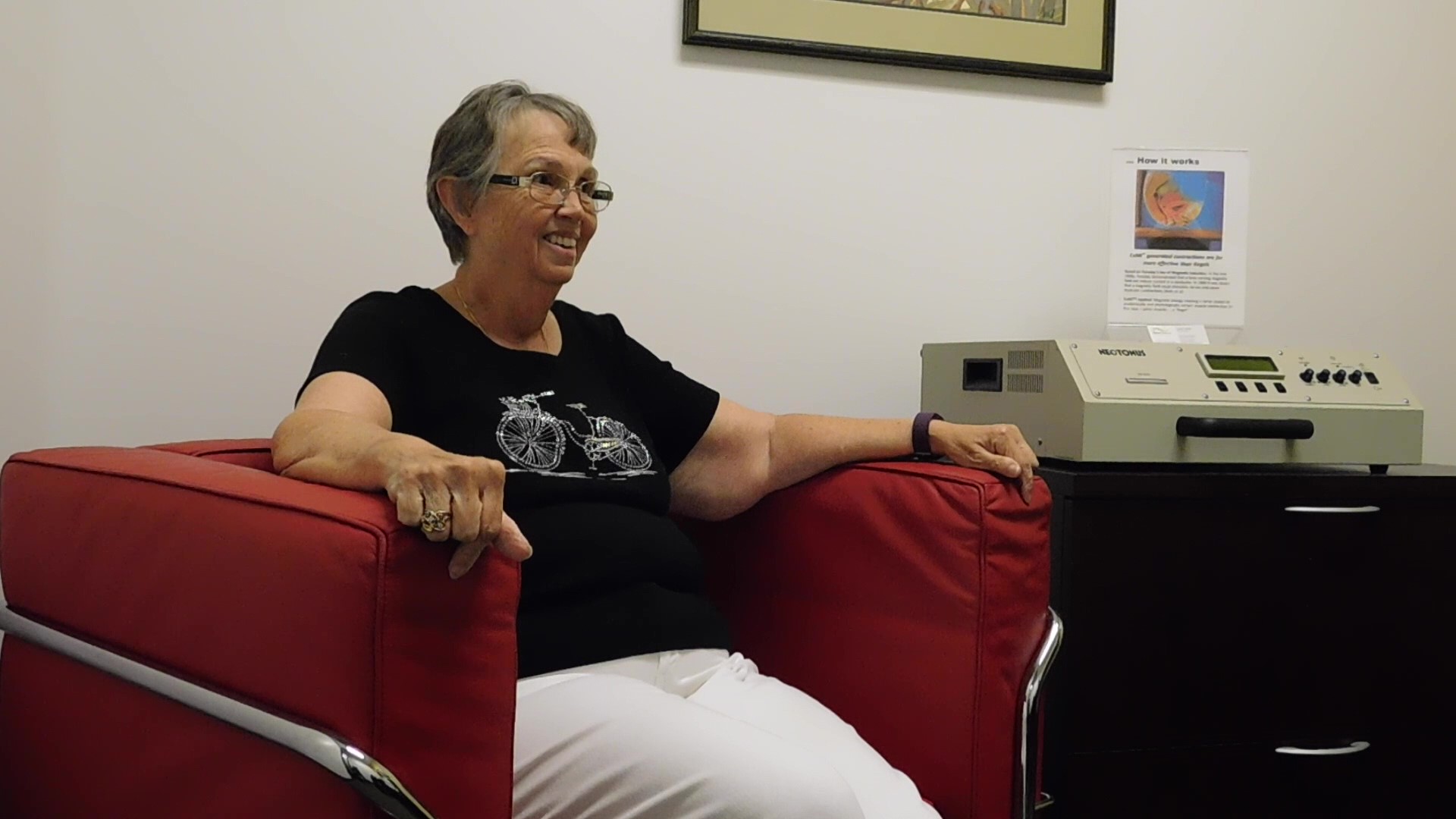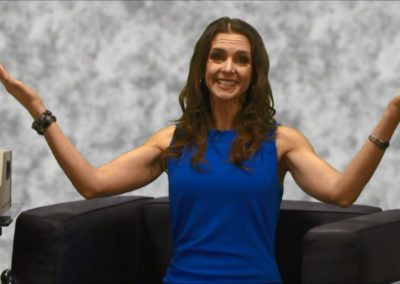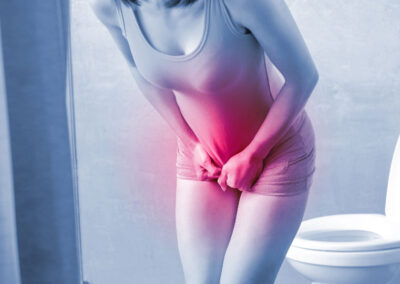how to repair the PELVIC FLOOR muscles?
EXMI PELVIC FLOOR MUSCLES REHAB technology
is There a treatment available that falls in line with the American Urological Associations guidelines for Bladder Weakness?
yes, It is called the ExMI Pelvic Floor Chair, you sit fully clothed for 20 minute sessions that stimulates all of the pelvic floor muscles through a magnetic wave.
-
The electromagnetic waves stimulate the muscular contractions of the pelvic floor resulting in 3,500 to 18,000 contractions which is far more than any Kegel exercise can achieve.
-
This is a FDA cleared devise for pelvic floor strengthening and treatment of urinary and fecal incontinence.
-
There are over 100 worldwide studies and publications that show significant efficacy.
• 85% for urge incontinence*
• 83% for stress incontinence**
• 70% Long term residual benefit for urinary incontinence***
A NEW DAY FOR THE HIDDEN SHAME OF INCONTINENCE
by Marna Rasmussen A.P.
Have you ever been mortified because you can’t find a restroom and you know you won’t be able to hold it? Have you been with friends or family having a great time and laughed so hard you peed yourself? How embarrassing! How about waking up at night knowing you have to urinate but can’t get to the bathroom in time. Urinary incontinence is not the only type of incontinence; there is also fecal incontinence, which can be even harder to handle. These scenarios are all too common for men and women who are dealing with the stigma of incontinence. Many are so embarrassed that they won’t even talk to their doctor about it. Incontinence, frequency of urination, urge control are all linked to serious declines in health because these are emotionally charged events. People dealing with incontinence stop socializing, stop having sex, and tend to be depressed and or anxious. Outside of embarrassment and shame, you may also feel a sense of impatience, frustration, annoyance, anger, fear, and/or disgust. Or you may sense theses emotions in others. It can feel dehumanizing, as if the condition has robbed you of your quality of life.
Definitions:
What is Urinary Incontinence (bladder weakness)? Bladder weakness is the complete loss of control of the bladder, Stress incontinence is the leaking of urine when coughing, sneezing, laughing or lifting objects. Overactive Bladder (OAB) is defined as the sudden compelling desire to urinate, a sensation that is difficult to ignore Urinary frequency is defined as voiding 8 or more times in a 24-hour period.
Nocturia is defined as the need to wake 1 or more times per night to void.
Fecal incontinence is the loss of bowel control.
*International Journal of Urology (2004) 11, 602-606
**Emory University Study, 1998
*** Abstract, Orlando Regional Healthcare follow-up study on ExMI therapy for UI
What is Extracorporeal Magnetic Innervation (ExMI™)?
is based on the principle described by Faraday’s Law of Magnetic Induction. In the mid-1800s, Faraday demonstrated that muscular contractions could be induced by the application of a time-varying magnetic field. ExMIT technology is a highly advanced and sophisticated implementation of this basic principle, designed to help physicians manage the complex medical problem of urinary incontinence.
ExMI technology works by producing a highly focused, time-varying magnetic field that penetrates deep into the perineum, innervating the pelvic floor muscles by activating motor neurons. Pulses of steep gradient magnetic flux are produced by the therapy head. These fields penetrate the patient’s perineum and initiate nerve impulses. The time-varying magnetic field creates an electrical potential, which causes an ion flow, or Eddy currents, in the tissues. This ion flow results in a depolarization of resting motor neuron membrane potentials. When a threshold potential is reached, an action potential is initiated for that neuron. This action potential then propagates naturally along the axion via the usual Na+ and K+ ion flows. Once these impulses reach the motor end plates, the musculature of the pelvic floor responds by contracting at a rate equal to the output pulse rate of the therapy head. The muscles contract and relax with each pulse. If the output pulse rate exceeds that of the muscles’ ability to contract and relax, the result is a constant, or steady, contraction of the muscles.
Simply put, ExMI technology induces nerve impulses, which cause muscle contractions and increase circulation.
Magnetic Neuromodulation
Since Michael Faraday discovered magnetic induction in 1831, we have continued to further our understanding and exploit the benefits of the interdependence of electricity and magnetism. Passing current through a coil of wire generates a magnetic field perpendicular to the current flow in the coil (right hand rule). If the coil is placed near a conducting medium, such as human tissues, and a time varying current is introduced into the coil, current will be induced in the conducting medium as a result of the changing magnetic field produced by the coil. One can think of the magnetic field produced by the coil as a non-invasive conduit between the electric current in the coil and the induced current in the tissues.
Who does bladder weakness affect?
• Urinary incontinence is a high risk factor for falling, causing injury or death.
• One in five adults over 40 years old have an overactive bladder, experiencing recurrent symptoms of sudden urges and frequent urination.
• According to the Center for Disease Control 50.9% of the people over 65 that are noninstitutionalized suffer with some form of incontinence issues.
• People who have had cancer, such as colon, bladder, uterine or prostate, all have greater incidences of incontinence.
• Of the 25 million adult Americans suffering from some form of urinary incontinence, 75-80% of those are women.1
• Urinary Incontinence affects 200 million people worldwide.1
• One in four women over the age of 18 experience episodes of leaking urine involuntarily.1
• Stress urinary incontinence, the most prevalent form of incontinence among women, affects an estimated 15 million adult women in the U.S.1
• About 17% of women and 16% men over 18 years old have overactive bladder (OAB) and an estimated 12.2 million adults have urge incontinence.1
• Urinary Incontinence is twice as common in women as in men.225% of men who have had radical prostatectomy surgery, or prostate cancer surgery will have some form of incontinence.
• Between the ages of 18 and 44, approximately 24% of women experience incontinence.3
• For women over age 60, approximately 23% deal with incontinence.
Sources
1 National Association for Incontinence, Facts and Statistics
2 WomensHealth.gov, Urinary incontinence fact sheet
3 American Medical Systems, Urinary incontinence
What is the cost for bladder weakness therapy?
The amount of money people spend annually on incontinence undergarments and pads is stunning. Incontinence is a $7 billion global market, and sales have grown more than 8 percent over the past five years—faster than the 5 percent to 7 percent growth in other products like toilet paper and tissues.
What are the current treatments for bladder weakness?
Behavioral therapy: The American Urological Association guidelines recommend that behavioral therapies (i.e., bladder training, bladder control strategies, pelvic floor muscle training, fluid management) should be offered as first-line therapy to all patients with OAB.
Strengthening the pelvic floor muscles with an exercise known as Kegels, can sometimes help people with stress incontinence and urge incontinence. Kegels can also help people with urge incontinence.
Drugs. For urge incontinence, medications known as anticholinergics/antimuscarinics (Detrol, Ditropan XL, Enablex, Oxytrol, Urispas, and Vesicare) can prevent bladder spasms. Oxytrol, Detrol, Ditropan XL, Myrbetriq, and Vesicare also are approved for women with OAB. Consult your pharmacist or doctor for short and long term use side effects to determine if drug therapy is right for you.
Devices. A pessary, a plastic device inserted into the vagina, may help prevent urine leakage by supporting the neck of the bladder; it is most useful for stress incontinence.
Surgery. There are several types of possible surgeries depending on the specific diagnosis. Consult your urologist for specifics and outcomes expected. Over the last 50 years, engineers and scientists have provided many new solutions to medical problems by allowing physicians to non-invasively enter the body. This has been done with a number of forms of energy to help diagnosis disease and trauma (x-ray, CT, MRI, ultrasound, etc.), and in a few cases, actually provide a therapy as with lasers, kidney stone lithotripters and gamma particle devices (Gamma Knife®). Pulsed magnetic neuromodulation provides the first non-invasive and focal technique to excite neurons to positively impact cell function and are neurologic and neuromuscular disorders.



